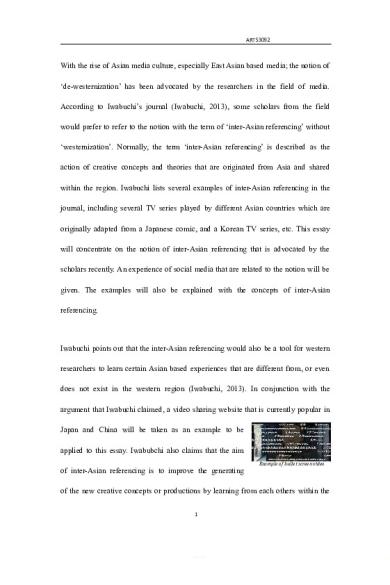A1 - Grade: 80 PDF

| Title | A1 - Grade: 80 |
|---|---|
| Course | Media And Transformation In The Asia-Pacific |
| Institution | University of New South Wales |
| Pages | 5 |
| File Size | 153.3 KB |
| File Type | |
| Total Downloads | 27 |
| Total Views | 160 |
Summary
Inter-Asian Referencing...
Description
ARTS3092
With the rise of Asian media culture, especially East Asian based media; the notion of ‘de-westernization’ has been advocated by the researchers in the field of media. According to Iwabuchi’s journal (Iwabuchi, 2013), some scholars from the field would prefer to refer to the notion with the term of ‘inter-Asian referencing’ without ‘westernization’. Normally, the term ‘inter-Asian referencing’ is described as the action of creative concepts and theories that are originated from Asia and shared within the region. Iwabuchi lists several examples of inter-Asian referencing in the journal, including several TV series played by different Asian countries which are originally adapted from a Japanese comic, and a Korean TV series, etc. This essay will concentrate on the notion of inter-Asian referencing that is advocated by the scholars recently. An experience of social media that are related to the notion will be given. The examples will also be explained with the concepts of inter-Asian referencing.
Iwabuchi points out that the inter-Asian referencing would also be a tool for western researchers to learn certain Asian based experiences that are different from, or even does not exist in the western region (Iwabuchi, 2013). In conjunction with the argument that Iwabuchi claimed, a video sharing website that is currently popular in Japan and China will be taken as an example to be applied to this essay. Iwabubchi also claims that the aim Example of bullet screen video
of inter-Asian referencing is to improve the generating of the new creative concepts or productions by learning from each others within the 1
ARTS3092
region. Indeed, the example could be perfectly represents Iwabuchi’s arguments. The genre of the video sharing website that will be applied here is called Danmaku Douga
Saito ( 弾 幕動 画 サイ ト ), or Dan’Mu ( 弹 幕 ) in Chinese, which could be directly translated as Bullet Screen video sites. As it is named, the difference between bullet screen websites and other regular video sharing sites, for example Youtube, is that all the comments are directly shown on the screen. That makes the audiences of the video feel like they are watching the videos with other users who are also interested in it at the same time. Nowadays, there are several famous bubllet screen video sharing websites within the East Asia region, including Bilibili, Niconico and Acfun.
Inter-Asian referencing is very significant for the study of East Asian media cultures. The very first bullet screen video sharing website is Niconico, a Japanese audiences based video website that was launched in the year 2006. The website was born from a very Japanese culture called ‘Otaku’. The term Otaku originally means a group of young people who are obsessed with Japanese animation cultures (Akio, 2008). Nowadays, the term has been shaped to refer to the bubble of the whole Anime lover
communities called Nijigen ( 二次元 ). The consequence of being an Otaku is that the activity area of the Otaku has been restricted in front of the TV or computers without socializing. The emergence of the bullet screen video sharing websites exactly reduces the loneliness caused by being Otaku. Therefore, the culture of watching 2
ARTS3092
bullet screen videos could only be seen in Japan at the first place. Back to now, the core audiences of the website are not necessarily those from Otaku communities, the bullet screen culture itself attracts more teenagers to try new way of watching videos.
With the expansion of the Japanese animations to the other countries in East Asia, especially China and Korea, the boom of the culture of bullet screen videos expanded at the same time. A traffic statistics done by Alexa, an Amazon website analysing company, indicates that Niconico is currently number ten popular in all Japanese websites ("Nicovideo.jp Traffic, Demographics and Competitors - Alexa", 2018). Moreover, except the main audiences group that the website is targeting on, which is audiences from Japan, the statistics also shows that there are about 7.9% of the audiences are from Korea, and 3.4% of audiences are from China. Iwabuchi quotes Chen’s idea of ‘Asia as method’ in his journal that a concept that are originated from a certain country could be considered as a referencing point that based on the fact that seeing the whole Asia as a entirety. In this case, the culture, or the concept of Otaku has been expanded and subjectively rebuilt in China. As the notion of ‘Otaku’ has gradually changed in Japan, the term gains more meaning in China. Henry Jenkins finds out that the term has been shaped as ‘fans’ in china, specifically animation fandom (Jenkins, 2013). As it is stated by Iwabuchi, such comparison within Asian region is meaningful for the media scholars to learn the original concepts from Asia.
Other than Niconico, China has its own bullet screen video sharing websites called
3
ARTS3092
Bilibili. The website is very similar to Japanese version of bullet screen video website, but it supports its users to upload their own videos directly on the website. In other words, except watching animations on Bilibili, the users could also upload videos about animations that are edited by those users, and other users could discuss the content of certain animations with Ups (the user who uploaded the videos) through bullet screen comments. This kind of video sharing websites gives the audiences a sense of belonging in a modern society.
Interestingly, back to the statistics that are shown above, there are about 0.5% of the audiences of Niconico website are from the US. Plus, the percentage of the audiences of Bilibili is 0.9% for the US audiences. It could be seen as a rise of the bullet screen video culture, or at a deeper level the Otaku culture, in the western region. Furthermore, the comments that fly across the screen on the largest game streaming website, Twitch, is an example of the expansion of the bullet screen culture, which refers to Iwabuchi’s idea of ‘inter-Asian referencing is significant for innovative production of knowledge because of such mutual learning process’.
In conclusion, this essay takes two of the most famous and important bullet screen video sharing website as an example of how the original Asian content are referenced by other countries within the Asian region, and then expand globally. The culture of Otaku exactly represents the Iwabuchi and Chen’s idea of Asia as a method. By the example of Twitch and the few audiences who log in to those bullet screen websites,
4
ARTS3092
the emergence of the Japanese animation fandom, and the culture of bullet screen in the Western region has been revealed. Reference list Akio, N. (2008). This City is Full of Otaku. Neojapanisme.
Iwabuchi,
K.
beyond. European
(2013). Journal
De-westernisation, Of
Cultural
inter-Asian
referencing
Studies, 17(1),
44-57.
and doi:
10.1177/1367549413501483
Jenkins, H. (2013). The Cultural Context of Chinese Fan Culture: An Interview with Xiqing Zheng (Part One). Retrieved from http://henryjenkins.org/blog/2013/02/thecultural-context-of-chinese-fan-culture-an-interview-with-xiqing-zheng-part-one.html
Nicovideo.jp Traffic, Demographics and Competitors - Alexa. (2018). Retrieved from https://www.alexa.com/siteinfo/nicovideo.jp
5...
Similar Free PDFs

A1 - Grade: 80
- 5 Pages

Apple - Grade: 80
- 8 Pages

Gout(notes) - Grade: 80
- 3 Pages

HD sample - Grade: 80%
- 16 Pages

Poetry Essay - Grade: 80%
- 6 Pages

Business summative - Grade: 80
- 17 Pages

Essay 3 - Grade: 80
- 4 Pages

FADO Music - Grade: 80%
- 7 Pages

A1 LFCB - Grade: 10
- 6 Pages

PSY3120 A1 - Grade: D
- 6 Pages

SLP - Grade: A1
- 3 Pages

The lindy hops - Grade: 80
- 2 Pages

Final lab report - Grade: 80
- 15 Pages

Peter the great - Grade: 80
- 1 Pages

Melanoma essay 1 - Grade: A1
- 3 Pages

10170420 BBE A1 - Grade: B
- 21 Pages
Popular Institutions
- Tinajero National High School - Annex
- Politeknik Caltex Riau
- Yokohama City University
- SGT University
- University of Al-Qadisiyah
- Divine Word College of Vigan
- Techniek College Rotterdam
- Universidade de Santiago
- Universiti Teknologi MARA Cawangan Johor Kampus Pasir Gudang
- Poltekkes Kemenkes Yogyakarta
- Baguio City National High School
- Colegio san marcos
- preparatoria uno
- Centro de Bachillerato Tecnológico Industrial y de Servicios No. 107
- Dalian Maritime University
- Quang Trung Secondary School
- Colegio Tecnológico en Informática
- Corporación Regional de Educación Superior
- Grupo CEDVA
- Dar Al Uloom University
- Centro de Estudios Preuniversitarios de la Universidad Nacional de Ingeniería
- 上智大学
- Aakash International School, Nuna Majara
- San Felipe Neri Catholic School
- Kang Chiao International School - New Taipei City
- Misamis Occidental National High School
- Institución Educativa Escuela Normal Juan Ladrilleros
- Kolehiyo ng Pantukan
- Batanes State College
- Instituto Continental
- Sekolah Menengah Kejuruan Kesehatan Kaltara (Tarakan)
- Colegio de La Inmaculada Concepcion - Cebu